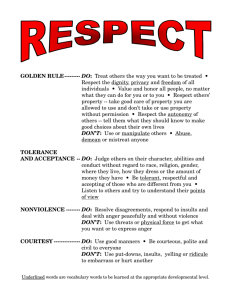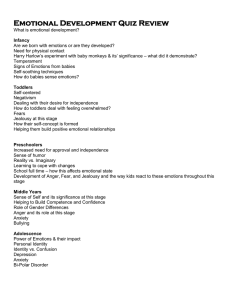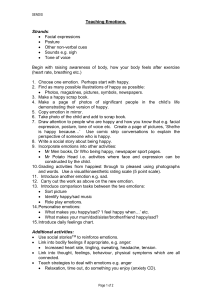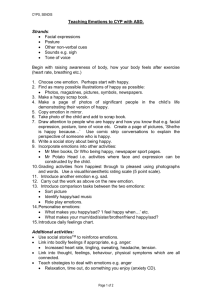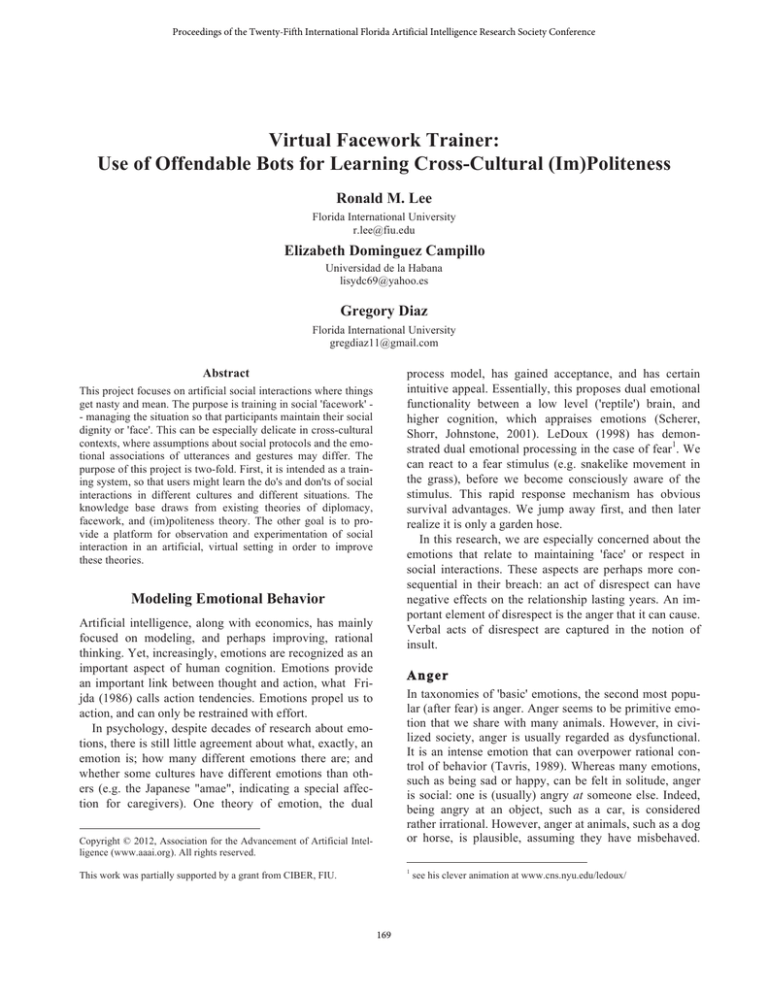
Proceedings of the Twenty-Fifth International Florida Artificial Intelligence Research Society Conference
Virtual Facework Trainer:
Use of Offendable Bots for Learning Cross-Cultural (Im)Politeness
Ronald M. Lee
Florida International University
r.lee@fiu.edu
Elizabeth Dominguez Campillo
Universidad de la Habana
lisydc69@yahoo.es
Gregory Diaz
Florida International University
gregdiaz11@gmail.com
Abstract
process model, has gained acceptance, and has certain
intuitive appeal. Essentially, this proposes dual emotional
functionality between a low level ('reptile') brain, and
higher cognition, which appraises emotions (Scherer,
Shorr, Johnstone, 2001). LeDoux (1998) has demonstrated dual emotional processing in the case of fear1. We
can react to a fear stimulus (e.g. snakelike movement in
the grass), before we become consciously aware of the
stimulus. This rapid response mechanism has obvious
survival advantages. We jump away first, and then later
realize it is only a garden hose.
In this research, we are especially concerned about the
emotions that relate to maintaining 'face' or respect in
social interactions. These aspects are perhaps more consequential in their breach: an act of disrespect can have
negative effects on the relationship lasting years. An important element of disrespect is the anger that it can cause.
Verbal acts of disrespect are captured in the notion of
insult.
This project focuses on artificial social interactions where things
get nasty and mean. The purpose is training in social 'facework' - managing the situation so that participants maintain their social
dignity or 'face'. This can be especially delicate in cross-cultural
contexts, where assumptions about social protocols and the emotional associations of utterances and gestures may differ. The
purpose of this project is two-fold. First, it is intended as a training system, so that users might learn the do's and don'ts of social
interactions in different cultures and different situations. The
knowledge base draws from existing theories of diplomacy,
facework, and (im)politeness theory. The other goal is to provide a platform for observation and experimentation of social
interaction in an artificial, virtual setting in order to improve
these theories.
Modeling Emotional Behavior
Artificial intelligence, along with economics, has mainly
focused on modeling, and perhaps improving, rational
thinking. Yet, increasingly, emotions are recognized as an
important aspect of human cognition. Emotions provide
an important link between thought and action, what Frijda (1986) calls action tendencies. Emotions propel us to
action, and can only be restrained with effort.
In psychology, despite decades of research about emotions, there is still little agreement about what, exactly, an
emotion is; how many different emotions there are; and
whether some cultures have different emotions than others (e.g. the Japanese "amae", indicating a special affection for caregivers). One theory of emotion, the dual
Anger
In taxonomies of 'basic' emotions, the second most popular (after fear) is anger. Anger seems to be primitive emotion that we share with many animals. However, in civilized society, anger is usually regarded as dysfunctional.
It is an intense emotion that can overpower rational control of behavior (Tavris, 1989). Whereas many emotions,
such as being sad or happy, can be felt in solitude, anger
is social: one is (usually) angry at someone else. Indeed,
being angry at an object, such as a car, is considered
rather irrational. However, anger at animals, such as a dog
or horse, is plausible, assuming they have misbehaved.
Copyright © 2012, Association for the Advancement of Artificial Intelligence (www.aaai.org). All rights reserved.
1
This work was partially supported by a grant from CIBER, FIU.
169
see his clever animation at www.cns.nyu.edu/ledoux/
This suggests that anger is somehow caused by the behavior of others, somehow in violation of our expectations.
tant redeeming grace: when asked, bots will explain to
you why they are angry.
The theoretical objective of this project is essentially a
situational theory of facework (or politeness / impoliteness). Every culture has certain do's and don'ts, some of
which can be learned from books such as the series Kiss,
Bow and Shake Hands (Morrison and Conaway 2006).
But this is essentially rote learning. What we are after is
deeper understanding of perlocutionary effects of crosscultural communications. Our method relies on a simulation platform to test theories about anger escalation and
other aspects of cross-cultural facework.
The practical importance of this project is as a training
tool for in cross-cultural facework -- especially in situations where there is distrust, potentially even hostility. An
example might be a business person venturing into foreign circumstances where there has been little or no cultural contact. Another example might be emergency aid
workers suddenly entering from abroad, e.g. the tsunami
in Indonesia, or the earthquake in Haiti. Another context
is military interventions where soldiers need to interact
with distrustful civilians.
Insults
Insults are a truly remarkable kind of speech act. By
simply uttering a word or two (or perhaps just raising a
finger), one can almost instantly transform the emotional
state of another person. Speech acts are usually analyzed
for their illocutionary effects -- the change in social state
brought about by their utterance (Kimbro, Lee, Ness,
1984). Insults are noteworthy for their perlocutionary
effect, the emotional effect they stimulate in others. Also
different from many other kinds of speech acts, insults
seem to have a greater potential for accidental performance. For instance, just using the wrong form of address
(tu versus vous; mister versus doctor) may be an unintended insult. When communicating across cultural
boundaries, the potential for unintended insults is greatly
increased. In one of the very few works specifically about
insults, Jerome Neu in his book Sticks and Stones (2007)
observes that there is a difference between being insulted
and feeling insulted. This is essentially the distinction
between the illocutionary and perlocutionary effects of
insults. To be insulted is socially defined, whereas to feel
insulted is the anger resulting from a perceived slight.
Here we are primarily interested in better understanding
the perlocutionary effects of insults -- what it is about the
situational context, roles and personal attributes of the
parties, and the linguistic form of the utterances, that are
so emotionally provocative.
For example, social interactions and situations have an
implicit level of formality, sometimes called the linguistic
register (Joos, 1967). For example, utterances acceptable
in a bar might be shocking in a college classroom. This
also applies to relationships: we have certain ways of
speaking with certain classes of people. Downward violations of register sound crass; upward violations might
sound arrogant.
Generalizing, people seem to project expectations
about how they should be respected by certain other people. When the expectations are not met, they may feel
insulted. These can range from broad, cultural rules (e.g.
proxemics or body distance during conversation); institutional (e.g. military protocols of saluting); or idiosyncratic
(e.g. my boss is very touchy about being overweight).
Related Work
Emotions are of tremendous importance for video games.
Indeed, the success of the game largely depends on the
nature, intensity, and duration of the emotions it creates in
the players. Freeman (2003) calls game design for emotional response 'emotioneering'. Bateman (2011) ranks the
top ten emotions experienced by game players as bliss;
relief; 'naches' (pride of accomplishment of one's children
or students); surprise; 'fiero' (triumph over adversity);
curiosity; excitement; contentment; amusement. Three
emotions least often experienced in gaming were the
negative emotions of sadness; guilt; and embarrassment.
From a sales/marketing standpoint, it is not surprising that
games avoid promoting negative emotions. It is also interesting that several of the emotions in this list are not
normally found in psychological taxonomies of emotion.
Perhaps games succeed, at least partly, by producing new
kinds of emotional experiences.
Our interest is somewhat different. Our primary goal is
not so much to provoke emotional reactions in the user,
but rather to develop a social interaction simulator to help
users to better understand emotional responses from other
people, and in particular, how to avoid angry, aggressive
responses. The purpose of the system is to facilitate understanding of how one's social interactions affect the
emotional responses of others. Terms for this include diplomacy; facework; politeness and impoliteness. We call
this kind of system a facework trainer.
In our search of the literature, we have found only one
other project that has a similar objective: the system is
called "FearNot!" (VICTEC 2005). The purpose of
Aim of Virtual Facework Trainer Project
The aim of this project is to develop a simulator for bots
that are culturally 'fragile' in the sense that they take offense easily. Furthermore, their anger can escalate, if they
are not treated properly. However, they have one impor-
170
FearNot! is interactive training for children (8-12) about
how to deal with school bullys: "to enable children to
explore physical and relational bullying issues and coping
strategies through empathic interactions with synthetic
characters." The technical details of this project are well
described in the MS thesis of João Dias (2005). Emotional
modeling in FearNot! in turn is based on earlier developments, especially by Gratch and Marsella (2003), who
provide a model for continuous emotional planning,
which differentiates behaviors according to the character's
personality.
speaker intended, and is not simply failed politeness". To
give a flavor for impoliteness analysis, these authors remark (p. 1549):
You have shit for brains could be interpreted as
very impolite for several reasons: (1) the criticism is personalized through the use of you (this
is, of course, also true of You fool), (2) shit is a
taboo word, and (3) the speaker flouts Grice’s
maxim of quality, in order to implicate the impolite belief that the target has absolutely no intelligence.
Rules that capture these aspects allow bots to formulate
their own impolite responses.
Facework, Politeness, Insults
A central concept for the study of conflict and aggression
is the notion of face. Face is essentially one's self-esteem
or dignity. It is internal emotional support that protects
oneself in a social situation. Normal, civilized behavior
seeks to avoid conflict stemming from acts of disrespect.
Our efforts to avoid threatening the face of others have
been dubbed "facework", originally by Erving Goffman
(1963). Facework is a definite social skill (Cupach and
Metts, 1994). Cultures have specific rituals for maintaining face, e.g. protocols of offering, acceptance and thanks.
Tact consists of ways to avoid embarrassing moments of
losing face. "Trouble is caused by a person who cannot be
relied upon to play the face-saving game" (Goffman,
1963).
In the lingo of street talk in the USA, to "dis" someone
is to disrespect them. This is a face-threatening act. Preserving face is important in practically all cultures and
sub-cultures. Stella Ting-Toomey has studied how facework strategies differ between national cultures (TingToomey, 2005). According to her face negotiation theory,
an important cultural variable is individualist vs collectivist. In individualist cultures, such as the United States,
Germany, and Great Britain, there is great value on personal rights, so that face issues are primarily about the
individual. Collectivist cultures such as Japan, Saudi Arabia, and Colombia, place more value on the face of the
group.
Another important cultural variable, according to TingToomey, is power distance. This refers to the degree and
importance of hierarchy in the culture. Low power distance cultures such as the USA value equality, whereas
high power distance cultures, such as Japan, place high
value and respect on authority. In the latter case, maintaining the face of a superior is potentially more important
than maintaining one's own face.
Closely related to theories of facework are theories of
politeness and impoliteness. The book Politeness by
Brown and Lewinson, (1978/1987) established politeness
theory as an important branch of socio-linguistics (Leech,
1983). Impoliteness theory is an offshoot from politeness
theory, but it is not simply a negation of the politeness
rules. According to Culpeper, Bousfield, and Wichmann
(2003, p 1546) "impoliteness fulfills a function that the
Modeling Anger and Aggression
As per the relevant literature (e.g. Handbook of the Affective Sciences, Davidson, Scherer, Goldsmith 2003), anger
is an internal emotion which may or may not be displayed
in observable behavior. Following Frijda (1986), emotions have 'action tendencies' -- they are primers for certain kinds of actions. For instance, the action tendency of
fear is to flee. The action tendency of anger is aggression.
As the intensity of the emotion increases, ever greater
effort is required to suppress the action tendency.
In addition to such action tendencies, human emotions
differ from animal emotions in that they have a strong
cognitive component, called appraisals (Scherer, et al.
2001). For instance, that a certain utterance is construed
as foul and offensive is something that is socially learned.
(Your cat is not offended.) One might appraise the smell
of gas during the night as something fearful. Again, the
cat does not make the connection, though it certainly detects the smell.
Dynamics: Escalation vs. Self-Control
An intuition of folk psychology and a theme in many
movies is that anger intensifies, until it overwhelms selfcontrol and violent rage ensues. However, this intensification process can also be interrupted, sometimes successfully (e.g. the police arriving). There is also a problem of
so-called displaced aggression, where the person interrupting becomes a surrogate target. Thus, domestic violence situations may be quite dangerous for the police that
intervene.
Escalation of Anger
While there is a great deal written about anger, there is
surprisingly little to be found about how anger escalates.
Zillmann (1994) is one of the few social psychologists
who have considered it with some detail. He comments
(p. 50):
Escalating conflict can be conceptualized as a sequence of provocations, each triggering an excitatory reaction that materializes quickly and that dissipates slowly. If a second sympathetic reaction oc-
171
curs before the first has dissipated, the second reaction combines with the tail end of the first. Moreover, if a third reaction occurs before the second and
first reactions have dissipated, this third reaction
combines with the tail ends of both earlier reactions.
In general, any excitatory reaction to provocation
late in the escalation process rides the tails of all
earlier excitatory reactions.
may be tempered by one's values, and politeness principles that apply in the current situation, as well as consideration of the personality of the other (e.g. will they return
the attack? maybe pull a gun?). Another input to the action regulator is self-control, which may deplete. The result is a response speech act (or possibly a physical action).
In face-to-face exchanges between humans, non-verbal
aspects may be very important, especially with regard to
impoliteness and the determination if a speech act is insulting (Culpeper, et al. 2003). These include facial expressions, tone of voice, gestures, and other forms of body
language. Givens (2012) provides a marvelous inventory
of these non-verbal aspects. In a computational setting, a
partial incorporation of such non-verbal aspects could be
included in a dialogue setting between a bot and a user,
with a video camera, using facial expression recognition
software (Visual Recognition, 2012). Indeed, this software has already been applied in SecondLife, whereby the
avatar imitates the user's facial expressions.
Self-Control
Several researchers, notably Baumeister and colleagues
(e.g. Baumeister and Heartherton, 1996), have done research into the mechanisms of self-control. Relating back
to the emotion-appraisal/aggression-response model suggested earlier, self-control is exercised when one or more
provocations lead to a strong sense of anger, but the individual resists the action-tendency towards aggression.
Various empirical studies by Baumeister and colleagues
have shown that such self-control is in limited supply, and
behaves something like muscular energy. Like a muscle,
self-control becomes depleted with repeated use in a brief
period. Replenishment of self-control is accomplished
either by rest or by a strong dose of positive affect (e.g.
laughter).
Target Functionality
Offendable Bots
Our target functionality for this project is what we call
'offendable' bots. We assume the bot engages the user in a
conversation, about some potentially provocative subject.
As is usual in conversations, there is a sequence of turn
taking -- first one party speaks then the other party
speaks. The view of a single round in this turn from the
bot perspective is shown in Figure 1. As indicated, the
bot's reaction to a speech act from the Other involves two
sub-processes. The first is the appraisal, which results in
an emotion. The second process is the bot's response.
Both appraisal and response have inputs of culture and
personality. These inputs are parametric in that they do
not change during the course of the conversation.
In refining this model, we want to show how the intensity of the bot's angry emotional response can increase
with each iteration. (Or maybe not, if the Other does certain anger reducing moves such as apologies.) Selfcontrol is exercised in the behavioral response module. As
discussed earlier, this is a depletable resource. If selfcontrol is diminished and anger continues to escalate,
there will be a certain threshold when the bot explodes
into a violent reaction. Thus, a number of gaming scenarios are possible to try and achieve some kind of diplomatic objective without the bot exploding in rage.
Emotional Interaction Model
Figure 1 reflects the cognitive/emotional process model of
a single bot. We want to emphasize that this is one possible model -- the framework will allow simulation of alternative models as well. An emotional interaction takes
place between two or more bots. In a training situation,
one of these roles might be taken by a human-operated
avatar. But for the sake of discussion, let us assume two
bots. Thus there would be two emotional process models
that exchange speech acts.
By speech act we mean either something that is said or
a gesture that has symbolic importance, such as slamming
a door in a way that expresses anger. Typically, a conversation is a series of 'turns' where one party says or does
something, and followed by the next party saying or doing
something. The schematic in Figure 1 is of a single turn in
an emotional conversation. The symbols in this figure use
a kind of Petri net notation, where the boxes are transitions, and the ovals are places. The hexagons are also
places, but are regarded as fixed, for the scope of the interaction. Thus, culture, one's own personality, the other's
personality, one's values, etc. are regarded as fixed during
the interchange, though they might of course change over
a longer period.
The process begins as an utterance is received as a
speech act. This is appraised according to culture rules
and aspects of one's own personality. The result is an
emotion. Emotions may decay over time. The emotion is
input to an impulse generator, which incorporates action
tendencies associated with emotions (e.g. anger creates
the action tendency to attack). These action tendencies
Explaining Anger
Artificial emotion, like artificial intelligence more generally, is based on rules. As noted above, the variables in
these rules may include aspects of culture and personality,
as well as emotion-provoking attributes of the situation
and history of the interactional dialogue. The rule struc-
172
ture of these bots affords a feature not often found in actual angry aggression: the bot can be asked to explain why
it has a certain angry emotion. This explanation feature is
extremely important for training as well as for theoretical
tuning of the anger model.
input as a stylized Petri net with primitives appropriate to
emotion process modeling3. The output would be a set of
Prolog routines, that would control the behavior of the
bot. Prolog is especially useful for customizing syntax for
rule-based shell languages. Additionally, it also includes
rule representation for definite clause grammars, which
facilitates the modeling the conversational interactions
among the bots.
We are experimenting with two virtual world platforms
for this project: SecondLife4 and OpenSim5. SecondLife
is quite popular, with millions of residents. However, with
SecondLife, one does not have direct access to the server
except via their rather limited scripting language. With
OpenSim, the server is also open source, so deeper modifications are possible.
As noted earlier, our special interest is in dialogues that
affect the emotions of the participants. One model we
developed focuses on just-in-time language and culture
training for emergency response workers for the Haiti
earthquake. In Haiti, while French is usually understood
in the major cities, people in villages and rural areas often
only understand Haitian Creole. Furthermore, the foreign
medics represent a medical paradigm that may be foreign
and even frightening to some locals, who may be accustomed to vodou (voodoo) medicine. In Figure 2, the little
girl (Mai) is actually a bot, who interacts based on a
grammar fragment for Haitian Creole (see Lee, 2012, for
more details about grammar modeling).
Figure 1. Emotional Interaction Process
Language Interface
We have not yet described how the user will interact with
these bots. Actually this aspect has been addressed in a
previous project, developed as a system called ChitChat2.
ChitChat provides a grammar driven interface for users to
compose sentences in a foreign language. It is designed to
communicate with language bots that also use the same
grammar as the composition interface. Thus, ChitChat
supports semi-structured natural language interaction in
specific problem domains. In the design of offendable
bots, we also assume that the user will interact with the
bot in the target foreign language. This offers the possibility that words and gestures that are innocent in one's home
culture (e.g. the American OK sign gesture) may be quite
offensive in the host culture (such as Brazil).
Another approach would be to parse the user's written
input and identify emotional words. This strategy has
been explored for English by Neviarouskaya, Prendinger,
and Ishizuka (2010). This strategy offers generality where
in cases where parsers for the language exist. However,
the ChitChat approach serves well for special purpose
dialogues, and other languages where parsers are not
available.
Figure 2. Avatars and Bot in Virtual Haiti
Comparison to Other Systems
Implementation Aspects
There are a couple of 'serious games' applications that
focus on foreign language and culture training. One of
The prototype is still in development. In its ultimate form,
we want it to be a kind of 'shell' for representing different
socio-emotional process models. The input would be a
graphics interface something like that in Figure 1, with
2
3
We have prior experience developing a graphics tool for Petri net process modeling, but in a quite different application area: international trade
procedures, e.g. Lee (1999).
4
www.secondlife.com
5
http://opensimulator.org
http://web.me.com/ronald_m_lee/ChitChat/
173
these is Alelo's Tactical Iraqi6, which is used for Arabic
language training for the military, and highlights cultural
sensitivities that may arise in soldiers' encounters with
Iraqi locals. Another interesting application, by Serious
Games Interactive7, is their Global Conflicts games: Palestine and Latin America, which uses the scenario is of a
journalist trying to uncover ethical abuses. Both of these
systems provide excellent graphic representations of the
local environment and especially the appearance and
mannerisms of local people. However, in neither case is
the underlying socio-emotional process model open to
inspection or able to provide explanation of behavior.
Moreover, these are sealed gaming applications -- the
process model that drives character behavior is not modifiable.
Cupach, W., Metts, S. 1994. Facework. Sage Publishing.
Davidson, R. Scherer, K., Goldsmith. H.H. 2003. Handbook of the Affective Sciences, Oxford University Press.
Dias, J. 2005. FearNot!: Creating Emotional Autonomous Synthetic
Characters for Emphatic Interactions. MS Thesis, Universidad Técnica
de Lisboa.
Elliot, C. (1992). The Affective Reasoner: A process model of emotions
in a multi- agent system. Northwestern University, PhD Thesis.
Freeman, D. 2003. Creating Emotion in Games The Craft and Art of
Emotioneering, New Riders Games Publishing.
Frijda, N. 1986. The Emotions. Cambridge University Press.
Givens, D. 2012. NonVerbal Dictionary of Gestures, Signs and Body
Language Cues. [http://center-for-nonverbal-studies.org/6101.html]
Goffman, E. 1963. "On Face-Work." Interaction Ritual New York:
Anchor Books.
Gratch J., Marsella S. 2003. Modeling Coping Behavior in Virtual Humans: Don’t Worry, Be Happy. In Proceedings of Second International
Joint Conference on Autonomous Agents and Multiagent Systems, Australia, 2003.
Remaining Mysteries
George Box (1979) remarked "All models are wrong;
some are useful." The process model presented here is
also wrong. There are certainly other aspects of insult /
disrespect that it does not (yet) include. At present, we
can model various speech act behaviors such as name
calling, lowered language register, obscene gestures, etc.
that provoke anger in the hearer. This by itself has value
for training purposes, especially for cross-cultural applications where learning facework symbolism of behaviors
is extremely important (Morrison, Conaway, 2006).
Beyond this, targeting anger as the key emotion triggered by disrespect seems inadequate. Anger by itself
dissipates, yet certain forms of disrespect can endure
years8. This suggests an interplay between social cognition and emotion, leading perhaps to such social emotions
as guilt, embarrassment and shame, which are not yet
addressed in our current model. For this reason, we are
attempting to make the system as open as possible for
future modifications and refinements.
Gudykunst, W. 2005. Theorizing About InterCultural Communication.
Sage Publications.
Joos, M. 1967. The Five Clocks. Harcourt.
LeDoux, J. 1998. The Emotional Brain, Touchstone.
Lee R. "Distributed Electronic Trade Scenarios: Representation, Design,
Prototyping", International Journal on Electronic Commerce Special
Issue on Formal Aspects of Digital Commerce, eds. S. O. Kimbough and
RM Lee, Vol 3, No 1, 1999, pp. 23-26.
Lee, R. 2012. ChitChat. Guided Grammatical Conversation in a Foreign
Language. (viewed Feb, 2012)
[http://web.me.com/ronald_m_lee/ChitChat/index.html]
Leech, G. 1983. Principles of Pragmatics. Longman Group Publishing.
Martinho C. (1999). Emotions in Motion. Universidade Técnica de Lisboa, MSC Thesis.
Morrison, T. and Conaway, W. 2006. Kiss, Bow, or Shake Hands, Adams Media.
Neviarouskaya, A., Prendinger, H., Ishizuka, M. 2010. Affect Analysis
Model. Natural Language Engineering, 17(1): 95-135.
Neu, J. 2007. Sticks and Stones The Philosophy of Insults, Oxford University Press.
Ortony A., Clore, G., Collins, A. (1988). The Cognitive Structure of
Emotions. Cambridge University Press, 1988.
References
Pool, J. 2011. C#Prolog. [http://sourceforge.net/projects/cs-prolog/].
(accessed November, 2011).
Bateman, C. 2011. Only a Game: Top Ten Videogame Emotions.
(viewed Nov, 2011)
[http://onlyagame.typepad.com/only_a_game/2008/04/top-tenvideoga.html]
Scherer, K. R., Shorr, A., and Johnstone, T. (eds.). 2001. Appraisal
Processes in Emotion Theory, Methods, Research. Oxford University
Press.
Baumeister, R. and Heatherton, T. 1996. Self-Regulation Failure: An
Overview. Psychological Inquiry (7:1) pp 1-15.
Tavris, C. 1989. Anger The Misunderstood Emotion. Touchstone Press.
Ting-Toomey, S. 2005. The Matrix of Face: An Updated FaceNegotiation Theory. In W.B. Gudykunst (ed.), Theorizing About
Intercultural Communication (pp. 71–92). Sage.
Box, G E.P. 1979. Robustness in the strategy of scientific model building, in Robustness in Statistics, R.L. Launer and G.N. Wilkinson, Editors. Academic Press.
VICTEC. 2005. Virtual ICT with Empathic Characters: FearNot!
(viewed November, 2011) [www.macs.hw.ac.uk/EcircusWeb]
Brown, P. and Lewinson, S. 1978/1987. Politeness -- Some Universals
in Language Usage, Cambridge University Press.
Visual Recognition. 2012. eMotion Software Now Integrates with Second Life (viewed February, 2012)
[http://staff.science.uva.nl/~aldersho/isis/VisualRecognition]
Conley, T. 2010. Toward a Rhetoric of Insult. University of Chicago
Press.
Culpeper, J., Bousfield, D., Wichmann, A. 2003. Impoliteness Revisited:
with Special Reference to Dynamic and Prosodic Aspects. Journal of
Pragmatics 35: 1545-1579.
Zillman, D. 1994. Cognition-Excitation Interdependencies in the Escalation of Anger and Angry Aggression. in Potegal, Michael and Knutson,
John (eds) The Dynamics of Aggression Biological and Social Processes in Dyads and Groups, Psychology Press.
6
www.alelo.com/language_culture.html
www.globalconflicts.eu
8
There is a Vietnamese saying: "For revenge, ten years is a short time."
7
174




